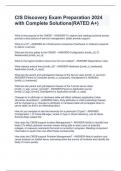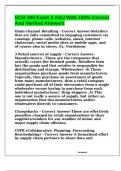CIS Discovery Exam Preparation 2024 with Complete Solutions(RATED A+)
What is the purpose of the CMDB? - ANSWER-To capture and catalog business assets,
provide a clear picture of service management, better provide support.
What is a CI? - ANSWER-An infrastructure component (hardware or software) required to deliver a service.
What are the key tables in the CMDB? - ANSWER-Configuration [cmdb_ci], CI Relationship [cmdb_rel_ci].
What is the logical model to show how CI's are related? - ANSWER-Dependency View.
What classes extend from [cmdb_ci]? - ANSWER-Hardware [cmdb_ci_hardware], Application [cmdb_ci_appl].
What are the parent and grandparent classes of the Server class [cmdb_ci_server]? - ANSWER-Parent is Computer [cmdb_ci_computer], Grandparent is Hardware [cmdb_ci_hardware].
What are the parent and grandparent classes of the Tomcat server class [cmdb_ci_app_server_tomcat]? - ANSWER-Parent is Application server [cmdb_ci_app_server], Grandparent is Application [cmdb_ci_appl].
Changes to to attributes in Hardware table will affect software (application) table structures (true/false)? - ANSWER-False. Only attributes in child (extending) classes will be changed (e.g. changes to attributes in hardware table will propagate down to server table, as this is an extending table).
How do you navigate to see the hierarchy for a particular CI type? - ANSWER-
Configuration > CI Class Manager, locate CI type in Class Hierarchy, use its Show Schema Map related link.
How does the CMDB support Incident Management? - ANSWER-Ability to identify how faulty CI's affect upstream services means being able to warn users of potential outages, or reassure customers that work is currently in progress. Relating component information to quick fixes can affect faster workarounds.
How does the CMDB support Problem Management? - ANSWER-Able to perform root cause analysis on related items, narrowing down the source of incidents and identify the
faulty CI more quickly. How does the CMDB support Change Management? - ANSWER-Understand change impact for more informed decision-making, identify upstream services and CI's affected by a change so change schedules can minimize service disruption.
How does the CMDB support Security Management - ANSWER-Identify assets and their business value to ascertain monitoring and control requirements.
The CMDB provides increased visibility of the infrastructure. What does this enable? - ANSWER-It enables key decision-makers to quickly make accurate and informed decisions, and for support teams to to investigate and resolve issues in a timely manner.
What risks are introduced by support staff not fully understanding their environment? - ANSWER-Support staff are not informed when devices are moved , Technicians lack details of a new server added to the network, Software is installed on corporate equipment without proper official approval, Costs and fines associated with under or over-buying software licenses.
How does a poorly maintained CMDB impede service management processes? - ANSWER-Incident resolution times extended due to additional information-gathering stages, prolonging outages.
Problem investigators searching in the wrong place or overlooking related items due to lack of configuration data.
Misunderstood change impact (unclear dependencies) could result in major incidents or catastrophic service outages.
What is ServiceNow Discovery? - ANSWER-It interrogates the enterprise recognizable devices and applications they host. Delegates work to MID servers.
Define the MID Server. What is its purpose? - ANSWER-MID: Management, Instrumentation and Discovery.
It is a lightweight Java process running under a Linux or Windows platform that resides within enterprise networks. Function: to execute work requests and return results to a SN instance for processing.
A MID Server is "a remote extension of the SN instance on the enterprise network".
How do a SN instance and MID server communicate? - ANSWER-Connections initiated from MID server inside firewall, using SOAP on HTTPS (port 443). All traffic is encrypted. Disco is agentless.
What are valid use cases for SN Discovery? - ANSWER-Inventory, licensing, CMDB population, CI relationship, application dependency mapping. What are the five steps for each phase in Discovery? - ANSWER-1) Output probes placed on ECC Queue
2) MID server regularly polls SN platform for work placed on the ECC Queue (in order to
be run, a record in the ECC queue must have value of output and state of Ready.
3) MID Server interrogates enterprise infrastructure to gather info about discovery target.
4) Responses placed in ECC queue as Output probes (an XML payload containing information).
5) Sensors decipher this payload and determine what course to take (classify type of device being interrogated/fire off more probes/create a new CI in the CMDB/update an existing CI with new attributes).
What are the phases of discovery? - ANSWER-Port Scan (Are you there?), Classification (How should I classify you specifically?), Identification (Have I seen you before?), Exploration (What else can you tell me about yourself?).
What occurs in the Scan phase? - ANSWER-First phase of disco. Shazzam probe launched (placed in ECC queue as output probe), scans for open TCP ports. Tries to get device type based on activity known to exist on these ports (e.g. UNIX uses port 22 for SSH, Windows uses port 135 for WMI).
From this, classify probes are launched.
What occurs in the Classification phase? - ANSWER-Classify sensors process data returned from classify probes (one per device), comparing against criteria for each class
of device, attempting to classify device specifically (e.g. determining if a Windows platform is 2003/2008/2012 etc).
What occurs in the Identification phase? - ANSWER-Patterns are launched via the Horizontal Discovery Probe. Using CI Identifiers, an attempt is made to match info against CMDB records. Match - updates existing CI record. No-match: insert or no action.
What occurs in the Exploration phase? - ANSWER-Patterns are gathering more detailed
information to populate CI attributes accordingly, both hardware and software characteristics.
What do Process Classifiers do? - ANSWER-They determine and track running processes by launching additional probes, creating child CI's, typically with a RUNS ON:RUNS relationship with their host.
How can discovery get information to draw relationships between applications on different computer systems? Where are these relationships displayed? - ANSWER-Ascertains TCP connections between systems and applications.
Displayed on the Dependency View map. What are some examples of common relationships in the Dependency View map? - ANSWER-RUNS ON:RUNS
DEPENDS ON:USED BY
RECEIVES DATA FROM:SENDS DATA TO
How does discovery differ from service mapping? - ANSWER-Discovery (application and infrastructure) addresses inventory-related use cases, scans everything.
Service mapping allows customers to create accurate maps of their application service topologies (top-down disco), needs an entry point and credentials for the supporting hosts of the applications.
What are the ITOM suite products available? - ANSWER-ITOM Visibility - Consists of discovery and service mapping. Gives service-aware view of infrastructure, continuously
monitors IT resources for changes and updates service maps.
ITOM Health - Consists of Event Management and Operational Intelligence. Helps track
and maintain health of services in your organization.
ITOM Optimization - Consists of Cloud Management and Cloud Insights. Provides an integrated, service-centric approach that maximizes business service quality, drive efficient processes, and ensures robust governance.
What is a subscription unit (SU)? - ANSWER-A generic unit of measure. A customer buys a pool of SU's per ITOM application.
Resource counts are mapped to SU consumption via standard ratios.
What is the ServiceNow store? - ANSWER-Online marketplace for downloading and installing SN applications.
After applications are approved by SN, they are available for installation on any SN instance running a version supported by the application. May be free or monthly subscription.
New patterns are regularly published on the SN store, outside of major releases (true/false)? - ANSWER-True, customers don't have to wait for major release in order to
use most recently updated patterns.
How do you navigate to update discovery content? - ANSWER-System Applications > All Available Applications > Installed, click Update.
What is the purpose of the discovery 'Home' page? - ANSWER-To provide a summary of discoveries that were triggered by cloud and non-cloud schedules during the last 30 days, including errors that might have occurred.
What is visible in the content frame from Discovery Home? - ANSWER-CI Schedules - Shows schedules
What is the purpose of the discovery dashboard? - ANSWER-Used to monitor ongoing Discovery operations. Contains reports that query the database and display the results.





